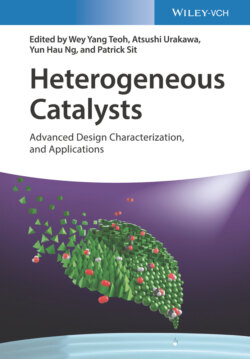Читать книгу Heterogeneous Catalysts - Группа авторов - Страница 45
4.2 Preparation of Catalysts on New Carbon Supports
ОглавлениеThe method of deposition of catalyst precursors must be different for sp2 carbon than for sp3 carbon due to the different chemical nature of both carbon atoms. Conventional carbon materials such as activated carbon have a turbostratic structure that consists of a random mixture of sp2 and sp3, which is difficult to control and quantify. Nowadays, new carbon materials have emerged with more defined structures and controlled sp2 or sp3 character. Carbon nanodiamonds are ideally pure sp3 carbon and are sometimes coated by a layer of sp2 carbon. By treating at high temperatures, nanodiamonds are converted into nano‐onions with sp2 character. Activated carbon usually contains a high proportion of sp3 carbon, whereas carbon nanotubes (CNTs) and graphene are mainly sp2, containing sp3 carbon atoms on defects and edges. Therefore, the proportion of sp3/sp2 is variable depending on the amount of point defects and the size of the basal plane. The creation of well‐defined carbon structures can enhance our precision control over the catalytic site location, interparticle distances, and metal catalyst size. In fact, the size of the carbon‐supported catalysts can be controlled down to clusters or even SACs, which in turn influences the catalytic selectivities and efficiencies.
In general, the anchoring of catalyst precursor is more difficult on sp2 carbon such as graphene than on sp3 carbon because the interaction is weaker in the former due to the “smooth” and “inert” surface of the basal plane. The interaction is stronger on the prismatic edges of basal planes (sp3), which accounts for only a minor fraction of the carbon material. The density of anchoring sites on graphene can be increased by doping, functionalizing, and creating defects or dangling bonds on graphitic lattices. Another option is to use the highly oxidized form of graphene, called graphene oxide (GO). The metal precursor can be directly attached to these defects in graphitic lattices with dangling bonds or to heteroatoms (hydrogen, oxygen, nitrogen, sulfur, etc.). These heteroatoms can function as ligands to attach the single‐metal catalyst. Furthermore, the good attachment of the metal to carbon or dopant atoms guarantees the stability of the catalyst under reaction conditions. The techniques of deposition of metal catalyst on different carbon materials are discussed in detail in the following sections.
